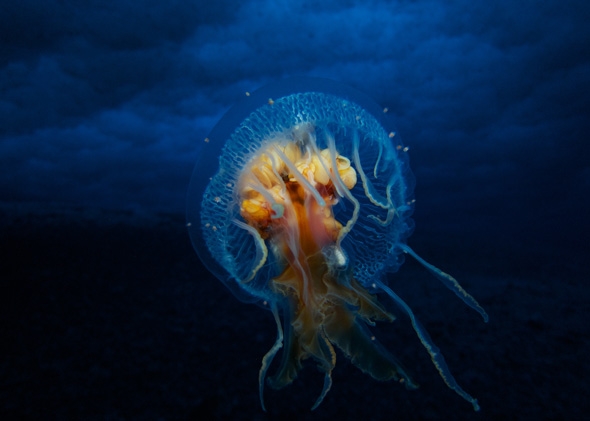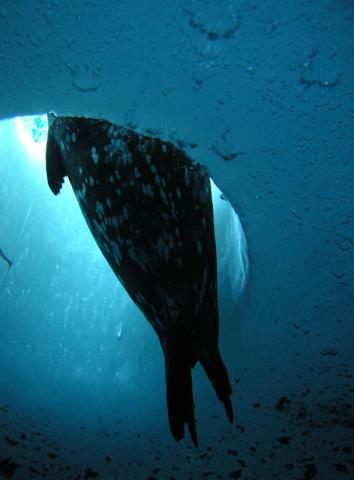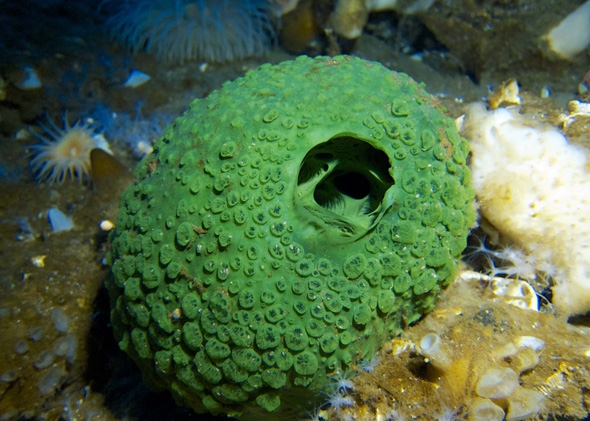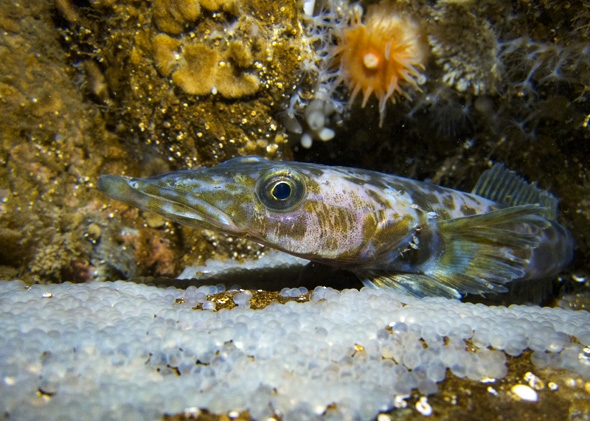The Gorgeous, Dangerous World Below Antarctic Ice (Op-Ed)


This article was originally published at Slate. The publication contributed the article to Live Science's Expert Voices: Op-Ed & Insights.
Rob Robbins and Steve Rupp have been diving under the Antarctic sea ice for a combined 60 years. Hang around their dive headquarters at McMurdo Station and you’ll see rows of oxygen tanks, wetsuits, and breathing apparatus; above an old mulberry couch, a map labeled Ross Sea Soundings in Fathom and Feet; a Magic 8 Ball (“we consult it for anything and everything!”), Maxwell House coffee grounds, and a wall of magnetic poetry (“nuzzle me bad”). You’ll hear constant jokes like “it’s a fish-eat-fish world” while reading daunting titles on the bookshelves: Proceedings of Repetitive Diving Workshop; Man in the Sea Volumes I & II; Mixed Gas Diving; and the Antarctica Scientific Diving Manual, which includes this advice: “drilling a safety hole allows continued surface access in cases where a Weddell seal appropriates the primary dive hole.”
Dive hole “appropriations” by curious seals are more like total coups d'état once one squeezes its 1,000-pound body up the blue hole and bobs around indefinitely. These incursions are a near-daily reality, and just one of the challenges unique to diving in Antarctica.
Other difficulties include the enormous risk of diving beneath an unending ice ceiling, the shocks suffered when wearing a heated suit underwater (Steve’s teeth keep getting zapped), and the one that horrified me most: enduring extraordinarily frigid water on your exposed face for half an hour or more. Rob, as well as the newest diver on their team, Martin Schuster, both swear they don’t even notice the icy water and cheerfully assured me that “the face goes numb so fast!” I smiled as though I agreed this was comforting information and moved one step closer to the diesel stove.
But I did believe Rob when he told me that even after 35 years of Antarctic diving, there’s never a single day when he’s not excited to go diving again. The contrast between the desolate white continent above and the explosion of bizarre and beautiful marine life below is just extraordinary. Beneath 10 feet of sea ice is a wildly colorful, dense, and ever-changing aquatic landscape, and Rob is one of the few humans who ever sees it firsthand: heaps of neon-pink sea stars, glow-in-the-dark jellies floating spookily by, yellow sea spiders breathing through holes in their bodies, amphipods, toothfish, and yes, hundreds of swirling seals.
These exotic polar animals are thought to be among the most vulnerable in the coming decades: They’ve enjoyed no less than 5 million years of an extremely stable, cold-water environment, and they may not have the capacity to adapt to our swiftly escalating ocean temperatures and acidification of the water. Furthermore, while many species on Earth—barnacles, butterflies, birds—are shifting their habitats poleward in search of cooler climates, where are the Antarctic animals supposed to go?
Get the world’s most fascinating discoveries delivered straight to your inbox.
An angry dragonfish once bit through a diver’s glove when he came for some of her eggs.
A team of environmental physiologists led by Anne Todgham is spending several seasons at McMurdo conducting experiments on two Antarctic species—the dragonfish and the emerald rock cod—to determine what their fate might be, and by extension, the fate of the larger polar ecosystem. Last week we piled onto snowmobiles and bright-red Pisten Bullies (vehicles and gear in Antarctica tend to be red or orange to make them easier to find in a rescue) and headed out with the divers to collect more juvenile fish samples.
I rode in a Pisten Bully with Ph.D. student Erin Flynn; we discussed the wonders of Green Apple Books in San Francisco, and munched on our peanut butter sandwiches, and Erin began knitting a hat from beautiful blue wool she picked up in New Zealand.* The volcano Mount Erebus loomed outside our window for most of the ride, smoldering with white fumes. We’d learned from an Antarctic vulcanologist (now there's a sexy job title) that Mount Erebus has recently surged in activity and is spitting out up to six firebombs each day.
More than an hour later, we arrived at our destination: a tiny heated shed plopped on top of a large hole drilled in the middle of the Ross Sea ice. Elaborate and lengthy preparations began: The three divers donned multiple layers of suits, tossed giant flippers around, and wiped down their fogged-up goggles with their thumbs. A rope with flares and flags was lowered down the hole, their dive-prep soundtrack of “American Woman” blasted from an iPod, and finally the divers strapped on their tanks and jumped into the hole, each making a cannonball splash. After all that commotion, the water smoothed back over, and it was eerily still and quiet. The other eight of us sat around the dive hole staring into the vertigo-inducing dark-blue waters, snacked some more (Fig Newtons this time—you have to eat constantly in Antarctica to keep your body temperature up), and listened to the intermittent buzz of the walkie-talkies from other field research sites (“Mac Ops, Mac Ops, how copy?”). The divers had told us that groups of juvenile cod flit in and out of cracks in a nearby ice wall. It was suspenseful to sit waiting in silence, wondering what it looked like down there and whether they were finding the fish. After 30 minutes, enormous bubbles began welling up in the hole, signaling the divers’ return.
On previous trips, the divers had carefully spatulaed up batches of dragonfish eggs, extraordinary pearlescent orbs laid on a single rock. Because the water is so cold, these eggs develop at a glacial pace, taking 10 months—longer than a human baby—to gestate. The dragonfish mother stands guard for most of this time; an angry dragonfish once even bit through a diver’s glove when he came for some of her eggs.
On this trip, the dive team gathered about 200 juvenile emerald rock cod, primarily using little green fishing nets, the kind you’d use in a child’s aquarium. As the divers emptied their tubes of collected fish into the waiting cooler, Todgham’s team huddled around to examine the catch. Soon the hut became filled with shouts like “We got some amphipods!” and “It might just be a bork!”
Back at Crary Aquarium in McMurdo Station, the science team moved the juvenile fish to their new aquarium quarters and checked on hundreds of other dragonfish eggs and cod juveniles that are part of their research. Dozens of containers are kept at different temperatures and bubble with varying amounts of carbon dioxide, which simulate the best- and worst-case scenarios for ocean warming and acidification forecasted for the next century. In the past 200 years, the ocean has absorbed 50 percent of our skyrocketing carbon emissions, and even if we hugely curb our destructive output, the ocean is still headed for a record change in temperature and chemical makeup. Todgham and her team want to know how the combination of warming and acidity will impact these fragile fish, which species have a fighting chance of adapting, and how their physiology might allow them to survive.
We gathered Saturday for an early Thanksgiving dinner, and each of us offered thanks to the team members for their hard work and positive spirits, and expressed gratitude that after the miserable U.S. government shutdown put the entire project (and all work on the continent) in peril, science was able to move forward after all. “I don’t think people realize how much can be accomplished, in a very short time, by a team of dedicated people like you guys all working and collaborating together,” said Todgham, raising a blue plastic cafeteria water glass filled with sauvignon blanc to toast the group. Somewhere below the sea ice, as we dug into our mashed potatoes and green beans, hundreds of dragonfish mothers stood guarding their eggs, dedicated and hard-working guardians of the next generation.
*Correction, Nov. 26, 2013: Due to an editing error, this post originally misidentified Ph.D. student Erin Flynn as Erin Flynn Klawitter. (Return.)
Jynne Dilling Martin is a poet and a 2013 Antarctica artist-in-residence. She is also publicity director of Riverhead Books, a division of Penguin Random House. The views expressed are those of the author and do not necessarily reflect the views of the publisher. This version of the article was originally published on Live Science.







